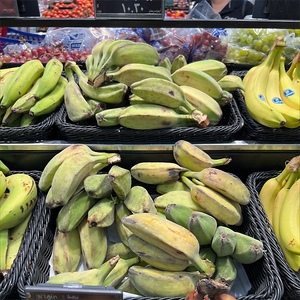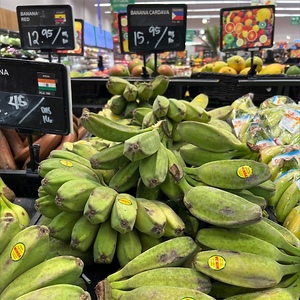


Cardaba Bananas
Estimated Inventory, lb : 0
Description/Taste
When ripe the exterior skin of the Cardaba banana will turn from green to yellow and will have a slight give when gently squeezed, similar to a ripe avocado. Compared to conventional bananas they are slightly shorter in length and wider. Their shape is curved with a pointed tip and boasts prominent ridges. The inner flesh is creamy white and fine textured with a sweet banana flavor. Its flesh is technically edible when raw, but it will be at its best flavor when used in cooked preparations.
Seasons/Availability
The Cardaba banana is available year-round.
Current Facts
Cardaba bananas are botanically known as part of Musa acuminate x balbisiana (ABB Group) ‘Saba’ and a member of the Musaceae family. The Cardaba banana is also known as Cardava and sometimes mistakenly called saba. The Cardaba is classified as a cooking banana or a balbisiana cultivar and along with the saba is the most common cooking banana cultivar in the Philippines. In addition to a source of fresh food the Cardaba banana is also used extensively in the production of banana based food products. The main Cardaba based product, banana chips, are also one of the country’s main export products which make the Cardaba one of the most important crops grown in the country.
Nutritional Value
Like most banana varieties the Cardaba banana is rich in potassium and carbohydrates. Additionally, they provide a good source of fiber and B vitamins.
Applications
The Cardaba banana is most often used in sweet and savory cooked applications. Sliced or whole Cardaba can be grilled or fried and topped simply with sugar. They can be boiled in sweet syrup or mashed and formed into pancakes then grilled. Wrapped in lumpia wrappers, they can be deep fried then served as a sweet or savory snack depending on what toppings they are paired with. Cardaba banana can also be caramelized and incorporated into desserts. Cardaba can be grilled, fried, or sautéed and served as a savory side dish. In addition to the fruit the leaves of the Cardaba tree can be used to wrap and cook food within and the flower of the tree used in a variety of Filipino dishes as well. The peels of the Cardaba bananas can also be used to make a vegan meat patty. The flavor and texture of the Cardaba banana pairs well with coconut, mango, jackfruit, custard, beans, brown sugar, butter, white rice, beef, eggs, and sweet potato. To store, keep Cardaba bananas in a cool and dry location, do not refrigerate.
Ethnic/Cultural Info
The Cardaba banana is used in many traditional Filipino foods such as banana ketchup, halo-halo, and a sweet stew known as binignit. It is also used to make a fried and sweetened banana on a stick known as banana cue, banana fritters or maruya, and fried banana spring rolls known as turon. The Cardaba banana is often used as a carbohydrate substitute for corn and rice and is being studied for its ability to provide a replacement crop for potatoes in areas impacted by crop failure due to climate change.
Geography/History
The Cardaba banana is native to the Philippines and along with the saba are the most common cooking banana cultivars grown there today. The banana has long been a highly important food crop in the Philippines providing not only a valuable source of food but also a means of income as an export crop. Since Cardaba bananas grow year-round, they provide a source of food security and can be used to supplement or substitute for other crops during times of and in locations prone to food scarcity. The Philippines is the only commercial level producer of the Cardaba banana though it can also be found growing on a very small scale in a handful of tropical and sub-tropical regions around the world. The Cardaba banana tree can be grown in most soils aside from highly sandy or rocky and prefers consistent warm and humid weather.
Recipe Ideas
Recipes that include Cardaba Bananas. One
| Panlasang Pinoy |
|
Saging Con Hielo (Banana with Caramel Sauce) |
Podcast









